VoIP, or Voice over Internet Protocol, is a feature-packed, budget-friendly alternative to traditional phone systems. But is it the right communication solution for your business?
We wrote the full guide weighing the advantages and disadvantages of VoIP phone systems to help you decide.
VoIP Advantages and Disadvantages: Overview
Want a quick overview? Watch our three-minute video on the pros and cons of VoIP below:

VoIP Advantages
Being VoIP providers ourselves at Nextiva, we have encountered many VoIP misconceptions, it would be fair to say we know a thing or two about VoIP. Here’s a detailed guide to its pros and cons:
- Lower costs
- Increased accessibility
- Complete portability
- Higher scalability
- Advanced features for small and large teams
- Clearer voice quality
- Supports multitasking
- More flexibility with softphones
1) Lower costs
The bottom line is vital for every business, large or small. So, you have to consider every cost-saving opportunity. One way companies can realize significant cost savings is by adopting a VoIP phone system.
Consider this:
On average, a landline phone system (POTS) costs businesses $50 per line each month. This rate comprises local (and sometimes domestic) calls only. VoIP plans, in contrast, are available for less than $20 per line.
Wait, what?
That’s right. Going by these figures means VoIP can lower your phone bill by more than half of what it is right now.
But what you can be sure about is that switching to VoIP will bring about considerable cost savings. Cost savings in VoIP come in two ways: direct and indirect.

Start calling for just $15/mo.
See why over 100,000 businesses switched to Nextiva. Now you can get it all for $15/month per user.
Direct cost savings
When it comes to traditional phone service, a business incurs massive initial costs. Especially in the name of business phones and PBX hardware.
a) PBX costs
A PBX (private branch exchange) is an on-premise physical piece of hardware. It connects many landline phones in an office and can cost a huge sum of money. We are talking tens of thousands of dollars — an amount you can amortize over several years.
You may argue that analog phones cost about the same as IP phones. The exact price will differ based on the desired features.
But onsite PBX installations are a costly capital undertaking. It can go for anywhere between $500 and $2,000 per user. So even a small business with a handful of employees needs to invest in physical hardware.
VoIP networks do away with this need for extra hardware since a broadband connection powers the service.
To ease the transition in their phone system upgrades, such organizations could use a Session Initiated Protocol, known as SIP Trunking. A SIP Trunk acts as a digital pathway for your voice services while maintaining existing phone hardware in your office.
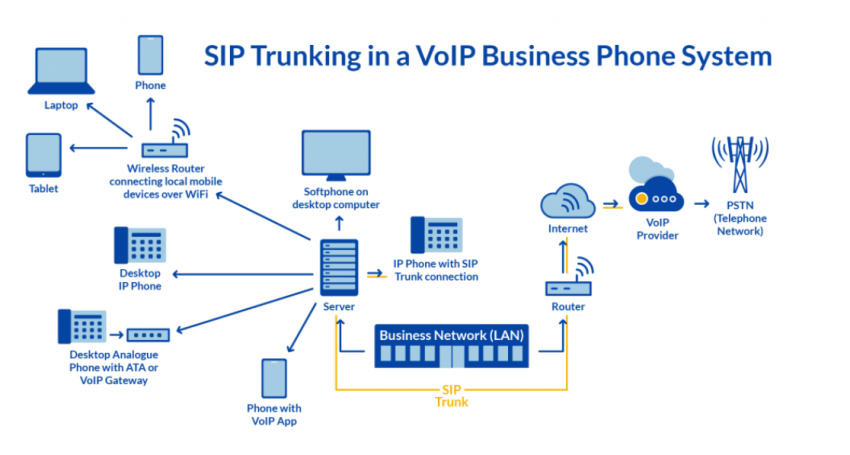
The key benefits of SIP Trunking include lower costs, easier to manage, and you can activate service instantly. Technology leaders use a SIP trunking provider for adding new voice capabilities to an existing phone system.
b) Copper wiring charges
Broadband connections also do away with the extra wiring because VoIP networks allow both voice and data on the same channel. In IT and telecom circles, the correct word for this is full-duplex. It’s the ability to send and receive voice and data concurrently. Most VoIP desk phones need only one Ethernet to be connected to it.
Power over Ethernet (PoE) enables offices to be more modular with their office staff. Additionally, those offices won’t need to make changes to the building’s electrical wiring.
Going completely wireless? Professional VoIP service is also available as an app on your computer or smartphone. VoIP’s flexibility is a big win for entrepreneurs and enterprises alike.
c) Calling expenses
Direct costs also come in the form of the cost of calling. VoIP calls are cheaper compared to the Public Switched Telephone Network (PSTN) or the traditional circuit-switched telephone network by a stretch.
A large part of this has to do with the drastic fall in data carriage costs. Initially, data was priced out of the reach of most small businesses.
Even for large organizations, users had to contend with capping on enterprise internet bandwidth and broadband. Today, however, internet speeds have improved while data costs have correspondingly taken a nosedive.
Statistics reveal that small businesses using VoIP can reduce their company’s phone bill by up to 60%. They can also save up to 90% on international calls.
One easy way is to choose the right business phone service and VoIP provider.

That’s a substantial number we are talking about in any given year.
These savings go back to the abandonment of expensive ISDN (short for Integrated Service Digital Network) primary rate interfaces. Or even the dedicated lines associated with a POTS system in favor of
VoIP service. Companies that make long-distance calls outside of the United States enjoy VoIP’s lower costs.
Traditional phone service costs approximately twice as much as compared to VoIP. VoIP offers a significant benefit for businesses that operate globally.
d) Recurring expenses
A VoIP service also enables businesses to cut other ongoing expenses such as taxes, repair, and maintenance fees. VoIP providers usually roll these costs into subscription plans which, like in the case of Nextiva, can cost as little as $5 per user per month.
All these costs, combined, make VoIP service an appealing proposition for growing startups and SMBs.
Indirect cost savings
Indirect savings are more difficult to quantify, but that doesn’t make them any less critical for your business. Below are some of the most common areas where organizations save money long-term.
a) Savings with remote work
Switching to VoIP lets employees stay connected to the corporate phone system while working remotely. This is thanks to the long list of VoIP phone features like call waiting, auto-attendant, instant video calling, conference calling, and others not provided by traditional phones.
Studies show that this not only can increase employee productivity, but it can also cut down on utilities and office space.
A typical business can save $11,000 per person per year by merely letting them work from home 50% of the time, according to a recent analysis by Global Workplace Analytics.
b) Add-on features at no extra cost
You probably might be quick to point out that even traditional PBX supports remote working through functionalities like call transfer, group ringing, call queuing, and so on.
In essence, these features are not inherent in a standard PBX system. Rather, they are add-on features that you have to pay for separately.
By comparison, VoIP phone services include many of these features at no additional cost. No need to pay extra for whatever feature you think could be useful for your business.
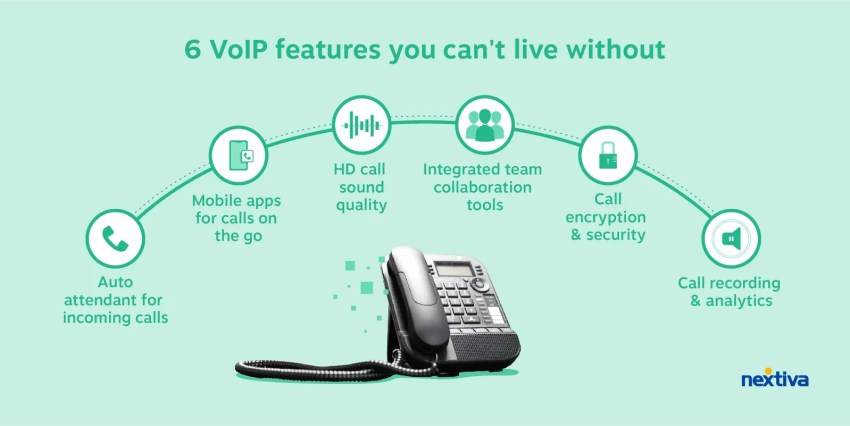
c) Repurposed manpower
If your business relies on a secretary to handle phone calls and take messages, the auto attendant feature lets you repurpose that role at no additional cost. (An in-house secretary hired on a full-time basis pockets about $45K a year, which is not cheap.)
Of course, a secretary does make sense for companies taking a large number of walk-ins or large corporations with sizeable budgets.
However, smaller businesses may find it difficult to justify this kind of salary. But with the auto attendant feature a click away, you’ve just waived this cost.
2) Increased accessibility
Cost efficiency aside, accessibility is one of the biggest benefits of VoIP for business. One distinct advantage cloud-based VoIP service offers is the ability to make calls from anywhere.
If you have a decent data connection, you can make and receive calls for your business. And when you’re unable to answer the call, you can direct calls to another person or get voicemails emailed to you. A noted benefit of VoIP is the ability to take your business phone with you with nothing more than a softphone app.
In an increasingly mobile workforce, remote accessibility allows your business to be flexible. Mobile employees can stay productive regardless of their location.
VoIP adapts based on how your employees work. Employees don’t need to be physically present at the office.
They can work on their smartphones and tablets from anywhere.
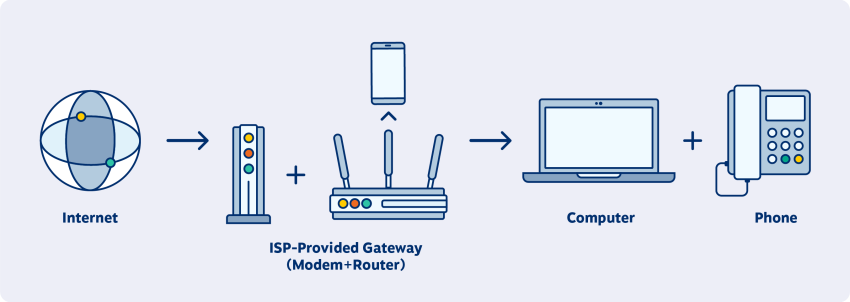
3) Complete portability
Your number, also known as a virtual phone number, is completely portable. This means you can use the same number wherever you go.
For people who travel a lot, this should be more than welcome news. Better yet, in the event your business changes address, you can retain the same VoIP number.
4) Higher scalability
Scalability is another of the many VoIP advantages that make it an attractive proposition for growing businesses. While this is an often-talked-about aspect of VoIP, what does it mean exactly?
Given the option, every business owner would prefer a phone system that grows in step with their business.
A VoIP solution does away with having to purchase expensive hardware or a dedicated line as you grow. Think of all the possible scenarios here like you’re:
- Prepping for a spike in demand during the holidays
- Opening a new branch office
- Adding new products and services
No matter what the scenario, toggle your preferences instantly without having to purchase additional lines or dedicated hardware.
5) Advanced features for small and large teams
With advanced features like auto attendant and call transferring, VoIP allows even a one-person operation to project the image of a larger company.
On the other hand, it can make a large enterprise feel more approachable. It’s all about making the best use of all the available features.
Let’s say you have a Charlotte-based business, but you also serve clients in a far-away state like Oregon.
By signing up with a provider like Nextiva, you get a VoIP phone number with the Oregon area code, although you’re based in North Carolina. This makes customers perceive you as a local, even though you are not.
Similarly, the auto attendant feature can make you look larger than you are. For example, you could be a sole proprietor but still set up your auto attendant to sound like you are a company with multiple departments.
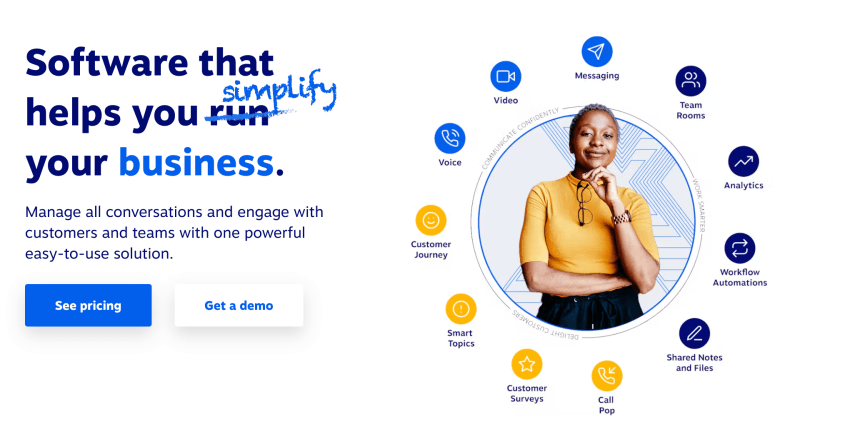
VoIP offers advantages over traditional phone systems with its multi-party calling capabilities. Organizations large and small often need a separate conference call provider that enables many people to join the same call.
Business VoIP providers include robust conference calling features built right into their service.
6) Clearer voice quality
When VoIP service first rolled around, one of its most significant disadvantages was its weak call quality. Calls would drop for no reason, the voice quality itself was bogus, and latency was the order of the day.
Today, as long as you have a fast and stable Internet connection, voice quality should not be an issue. VoIP calls tend to be crisp and clear, with no latency issues, lag, or call dropouts. We’ve all been on a miserable voice and video conference before.
The key to VoIP call quality is a robust connection with good bandwidth. Without this, it can be a nightmare, especially if you often find your office making concurrent calls. There’s always someone who calls in with a cell phone, and everyone else suffers through echoes, delays, and background noise.
VoIP phones end those interruptions so you can focus on the meeting’s agenda. Innovations such as noise-canceling microphones and advanced audio compression enable VoIP phones to achieve superior sound quality.

7) Supports multitasking
Along with traditional phone calls, VoIP allows you to send documents, images, and videos all while simultaneously engaging in a conversation. So you can seamlessly hold more integrated meetings with clients or staff from other corners of the globe.
8) More flexibility with softphones
Despite the name, softphones are not hardware devices. Instead, they are programs installed on a computer or other smart devices like a tablet or smartphone.
A good example is Skype, although enterprise VoIP providers like Nextiva have their applications tailored particularly for business.
The upside to having a softphone for your business communications is manifold:
- Frees up desk space
- Cuts additional equipment costs
- Allows for even greater portability
- Enables the constantly-connected workforce
More than that, softphones allow you to be flexible. They give you access to features that support your remote work style.
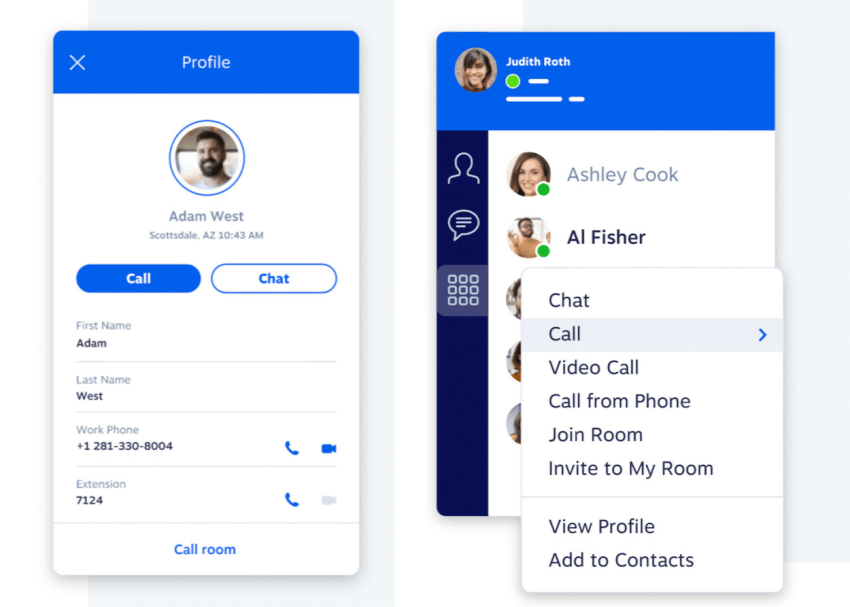
9) Increased security
Most people don’t care to spend more time than it’s worth to think about the security of their phone system. Phone system security is a big deal, especially for businesses. Demand for personally identifiable information (PII) has never been higher.
A typical entry point is to trick staff through fraudulent phone calls, typically known as social engineering.
VoIP can mitigate such security threats by leveraging the advancements made in IP technology including encryption and improved identity management. Hosted VoIP providers work around the clock to protect their networks, so you don’t have to.
Securing your VoIP system means you should work with a trustworthy VoIP provider that undergoes independent security audits, ensures staff practices healthy password habits, and configures automated alerts for questionable calling behavior.
Additionally, it is always advised to complete operating system updates consistently to ensure your business isn’t at risk through newer vulnerabilities.

VoIP Disadvantages
Everything that has an advantage has its disadvantages. VoIP telephony is not exempt from this rule.
Here are the downsides associated with the VoIP service you need to be aware of:
- Needs a reliable internet connection
- Susceptible to network jitter
- Limited location tracking for emergency calls
- Compatibility issues with some traditional alarm systems
- Security concerns
1) Reliance on a stable internet connection
VoIP calls travel over your internet connection, so a reliable connection is crucial for smooth operation. If your internet drops frequently, expect choppy calls or even complete outages.
A minimum upload speed of 100 kbps per device is recommended. While VoIP is efficient, low speeds can lead to dropped calls and lag.
Low latency (signal delay) and jitter (variation in latency) can also impact call quality. Think of it like a bumpy road for your voice data — the smoother the ride, the clearer the call.
The good news is that VoIP uses less bandwidth than you might expect, so you won’t need expensive internet phone service. A reliable plan should suffice for most users who work from home.
Types of connections best for VoIP:
✅ Fiber internet
✅ Cable internet
✅ DSL internet
✅ LTE internet (cellular)
✅ 5G internet (cellular)
❌ Satellite internet
❌ Dial-up internet
For larger businesses, the bandwidth will depend on the number of concurrent calls you plan on making. The best way to determine this is to run a bandwidth test on your current network to make sure you don’t face VoIP issues.
2) Susceptible to latency and network jitter
Along with internet speed, two other issues can affect your communication experience: latency and jitter.
- Latency is the delay in sending and receiving information online. High latency means there’s a lag between pressing a button and seeing the action happen on screen.
- Jitter is the inconsistency in that delay. With low jitter, the delay might be slightly noticeable, but it stays consistent. High jitter means the delay keeps jumping around, making the connection feel jumpy and unreliable.
When communicating online, information travels in tiny packets and each message (whether email, video, or audio) is broken into bits of data called “data packets.” Ideally, these packets travel smoothly and arrive in the right order.
Latency and network jitter happen when data packets experience delays during transmission, increasing the time it takes for information to arrive, and when packets take wrong turns or get stuck, causing delays and requiring retransmission.
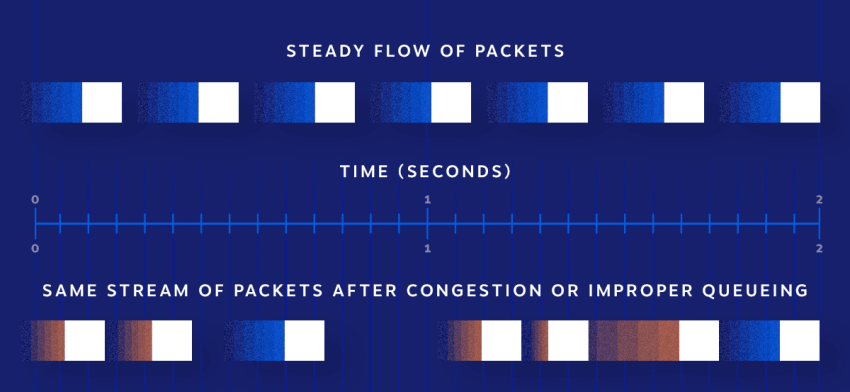
These issues can arise from various factors, like a crowded internet connection, outdated equipment, or worn cables.
You can easily minimize latency and jitter for a better online experience with a few best practices:
- Upgrade your internet plan: Consider a higher bandwidth plan from your ISP to handle the data flow.
- Invest in a quality router: A good router prioritizes voice traffic for smoother calls.
- Replace worn cables: Use Cat-5e or Cat-6 Ethernet cables for optimal performance.
- Enable jitter buffering: This feature, often pre-enabled on VoIP devices, helps absorb slight variations in packet arrival times, minimizing their impact on call quality.
3) Limited location tracking for emergency calls
One important difference between traditional phone lines and VoIP is emergency calling. With a cell phone, emergency services can use cell tower data to locate you in an emergency. However, VoIP calls rely on IP addresses, which aren’t as precise for location tracking.
While this isn’t a concern for most calls, it’s crucial for emergencies. To have help arrive quickly, keep your E-911 information updated with your current address, so emergency services can identify your location even when using VoIP.
4) Compatibility issues with some traditional equipment
Some older types of alarm systems and fax machines don’t work with VoIP.
There are two ways to address this:
- Upgrade equipment: For many businesses, modernizing equipment with cellular connectivity is the preferred solution.
- Use an ATA: An Analog Telephone Adapter (ATA) can convert analog signals from older equipment to work with VoIP.
But why do compatibility issues occur?
Traditional phone lines transmit analog signals, while VoIP uses digital data. This conversion process (modulation) can slightly alter the signal, causing problems with incompatible equipment.
5) Security risks
As with any internet-based technology, VoIP is susceptible to security risks such as hacking and phishing attacks. Hackers could potentially eavesdrop on calls, steal data, or disrupt service. What can you do to keep your business secure?
- Choose a reputable VoIP provider: Look for a reliable VoIP service with a strong track record of security that offers features such as encryption and two-factor authentication.
- Educate your employees: Train your employees on VoIP security best practices, such as how to identify phishing attacks and how to create strong passwords.
- Keep software up to date: Make sure your VoIP software and devices are always up to date with the latest security patches.
VoIP Advantages and Disadvantages Summarized
| Feature | Advantage | Disadvantage |
|---|---|---|
| Cost | Lower phone bills, eliminates expensive hardware | Requires reliable internet connection |
| Accessibility | Make and receive calls from anywhere | Limited location tracking for emergency calls |
| Portability | Take your phone number with you if you move | May not be compatible with older equipment |
| Scalability | Easily add or remove phone lines | Vulnerable to security risks |
| Features | Auto attendant, call forwarding, voicemail transcription, etc. | Reliant on good internet quality for clear calls |
| Voice quality | Superior voice quality | Jitter can cause choppy or broken audio |
| Multitasking | Send documents and images while on calls | Requires security awareness to avoid hacking and phishing |
| Flexibility | Use softphones on computers or mobile devices |
Best Practices for Maintaining VoIP Quality
When challenges creep in, you don’t have to look the other way. Follow these best practices to ensure smooth and reliable VoIP calls:
- Monitor your network performance: Regularly monitor your internet connection speed for signs of jitter. Many VoIP providers offer tools and VoIP speed tests to help you monitor your network performance.
- Optimize your network bandwidth: Your internet plan should have enough bandwidth to support your VoIP needs. A good rule of thumb is to have at least 100 kbps of upload speed per VoIP device.
- Prioritize VoIP traffic: Configure your router to prioritize VoIP traffic (SIP traffic) over other types of internet traffic, such as video streaming, so your voice calls have the bandwidth they need for optimal quality.
- Use high-quality equipment: Invest in high-quality VoIP phones and headsets for clear audio quality and to reduce dropped calls.
- Conduct regular maintenance: Perform regular maintenance on your VoIP system, such as updating software and firmware. Keep your system running smoothly and securely.
- Test your system regularly: Schedule regular test calls to check for any problems with your VoIP system to identify and troubleshoot any issues before they become a problem for your users.
- Develop a disaster recovery plan: Have a plan in place in case of a power outage or internet disruption. This could include having a backup internet connection or using a mobile VoIP app.

Making the Switch To VoIP: Set Up and Benefits
How do you switch to VoIP?
One of the key benefits of VoIP is its relative ease of use. There are three main ways to connect to a VoIP service provider:
- Dedicated VoIP phones: Offer a familiar phone experience with high-quality audio. Simply connect to your internet router via ethernet or Wi-Fi. It’s a great option for home users.
- Analog telephone adapters (ATA): These adapters allow you to use your existing landline phone with a VoIP service. This can be a good option if you’re comfortable with your current phone but want the benefits of VoIP.
- Softphone applications: These software programs let you make and receive VoIP calls using your computer, tablet, or smartphone. It’s a convenient option for those who already use these devices for communication, travel frequently, or work remotely.
Businesses are particularly drawn to VoIP due to its cost-effectiveness and scalability. VoIP eliminates the need for separate private branch exchanges (PBXs) and data lines, leading to significant savings on monthly bills. VoIP plans often offer features like call forwarding and voicemail at no extra charge.
Unifying voice and data on a single network (phone calls, SMS, email, faxes, web conferences, and more), VoIP streamlines communication for businesses. You get features like video conferencing and collaboration tools, all accessible through the internet.
VoIP can spur growth in both enterprises and SMBs, without much of a budget to work with.
Choosing the Right VoIP Phone System
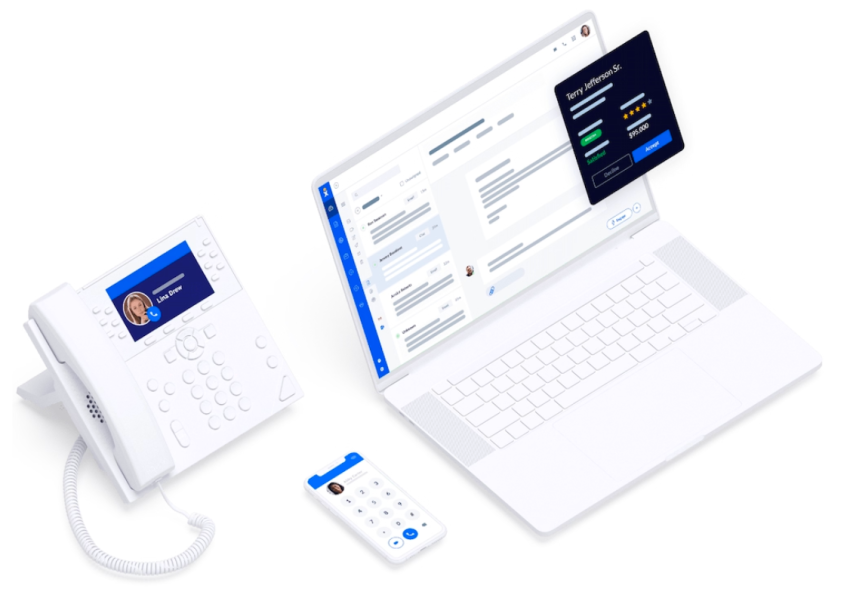
Looking at the pros and cons above, it’s clear that the benefits far outweigh any VoIP’s disadvantages. Now how do you choose the right VoIP phone system?
Here are some key questions to ask:
- Features: Do you need basic call functionality or advanced features like video conferencing and call recording?
- Scalability: Can the system easily adapt as your business grows?
- Security: Does the provider offer robust security measures to protect your communication channels?
- Budget: Do the pricing plans and features fit your budget?
At Nextiva, we understand the importance of seamless communication for businesses of all sizes. We offer a wide range of VoIP solutions packed with features that boost your team’s productivity and efficiency.
Our team of experts guide you through every step of the process, from initial setup to ongoing support. We ensure a smooth transition with minimal disruption to your daily operations, allowing you to focus on what matters most — running your business.
To learn more about our products and what we can do to help your company, check out our business phone service.
Start calling for just $15/mo.
See why over 100,000 businesses switched to Nextiva. Now you can get it all for $15/month per user.

















 VoIP
VoIP 















